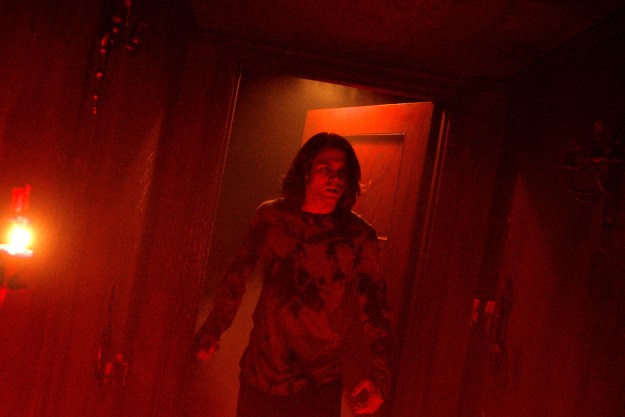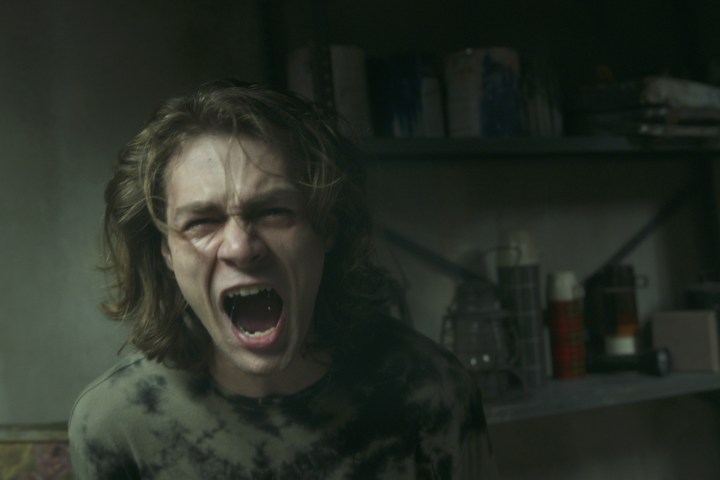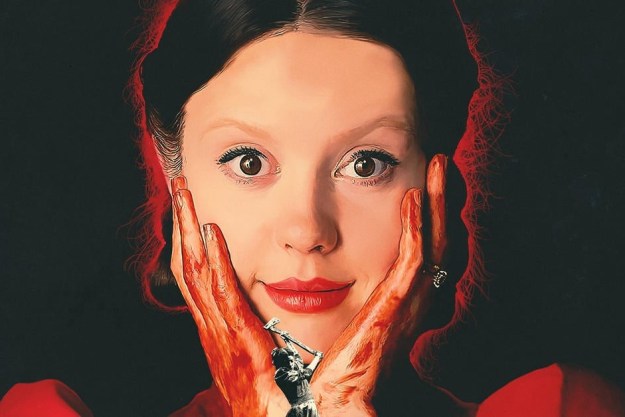
“Insidious: The Red Door is an occasionally scary but frustratingly inert slice of horror entertainment.”
- Patrick Wilson's capable direction
- Several standout horror set pieces
- A cast of one-note characters
- A disjointed, overly cyclical structure
- A toothless third act
Insidious: The Red Door won’t knock your socks off, but it will make you jump in your seat a few times. The fifth installment in the Insidious franchise and a direct sequel to 2013’s Insidious: Chapter 2, the new film benefits from its own heightened level of accessibility. As clunky as it may be, the film’s opening scene ensures that its viewers don’t need to be too familiar with its franchise’s previous installments in order to follow along with its story. In an age when it feels like nearly every blockbuster movie comes with its own set of homework assignments, that’s an unexpected blessing.
As refreshingly direct as it is with its intentions, though, Insidious: The Red Door suffers greatly from a lackluster script by Scott Teems, which struggles to bring any dimensionality to the film’s story and characters. Visually, the direction from franchise lead Patrick Wilson, who makes his directorial debut here, is pedestrian but capable. The actor-director demonstrates a fundamental understanding of how to use basic tools like blocking and focus to devastatingly scary effect. His simple style, nonetheless, marks an inevitable step down for a franchise that was initially helmed by The Conjuring filmmaker James Wan.

Insidious: The Red Door begins where its 2013 predecessor left off, with father-son duo Josh (Wilson) and Dalton Lambert (Ty Simpkins) agreeing to have their traumatic memories of the spirit realm known as “The Further,” as well as the undead spirits that lurk within it, suppressed. When the film catches back up with Josh and Dalton (an older, broodier Simpkins) nine years later, it’s revealed that the blank spots in their memories have created an emotional rift between the two. However, when Dalton inadvertently paints a door to The Further, he makes both himself and his father vulnerable again to the demons of their past.
Thanks to its leads’ geographical separation from each other, Insidious: The Red Door spends most of its first and second acts alternately terrorizing Josh and Dalton with horrifying visions and supernatural attacks. Some of these sequences are more effective than others, but not even The Red Door’s scariest moments are able to distract from the fact that its structure is extremely one-note and repetitive. While the film’s exploration of Dalton’s lingering childhood trauma is occasionally compelling as well, his enforced distance from Wilson’s Josh prevents their relationship from ever deepening or growing in its complexity.
The flatness of The Red Door’s story isn’t helped by its uninteresting supporting characters, which include Professor Armagan (Succession‘s Hiam Abbass), Dalton’s commanding but totally unexplored art teacher, and Chris Winslow (Sinclair Daniel), Dalton’s college roommate. Given how unbelievably she acts throughout The Red Door, the latter character might as well be a Manic Horror Dream Girl, while Rose Byrne understandably sleepwalks through the few underwritten minutes she gets to reprise her role as Renai, Josh’s former wife and confidant.

Its lifeless plot and characterizations aside, Insidious: The Red Door is, at times, as terrifying as any other mainstream horror film that’s been released this year. Many of its second-act set pieces are rendered inconsequential by the film’s cyclical structure, but that doesn’t mean some of them aren’t unnerving. A sequence involving Simpkins’ Dalton and the perpetually vomiting ghost of a dead college kid features the film’s best use of sound design, as well as a fun inverse on the monster-under-the-bed trope that feels, whether intentionally or not, reminiscent of the scariest scene from Kiyoshi Kurosawa’s far superior Pulse.
Another memorable sequence traps Wilson’s Josh in an MRI machine and utilizes his character’s limited visual perspective to significantly ramp up the tension before delivering Insidious: The Red Door’s best and most bone-rattling jump scare. Together, these scenes establish Wilson’s technical capabilities as a director and even suggest that he may be able to produce a great horror film one day — so long as he’s given a better script than the one he was supposed to work with here. The Red Door makes it clear that Wilson knows how to visually construct a horror sequence, but his efforts are frequently hampered by the film’s disjointed, often illogical screenplay.

Like so many horror movies before it, Insidious: The Red Door becomes significantly less scary the more that it reveals about its plot and monsters. The film’s third act, which tries unsuccessfully to evoke the mood of an Argento-inspired Giallo horror movie, is dragged down significantly by an unearned sentimental streak and a profound lack of legitimately scary moments. All of these mistakes lead The Red Door toward a climax that not only falls short of the visceral terror it wants to achieve but also ends on an unsuitably saccharine note.
Overall, the film is best enjoyed as a lightweight addition to the same jump scare-centric brand of horror that some of Wilson’s previous collaborators — namely, James Wan — have perfected and popularized. It isn’t as effective as any of the films it tries to emulate, but it does have a handful of genuinely terrifying moments. Much like the painting that causes its characters so much trouble, Insidious: The Red Door is a disappointingly paper-thin construction, but one that does have the capacity to be striking, depending on which angle you look at it from.
Insidious: The Red Door is now playing in theaters.
Editors' Recommendations
- 3 great Netflix horror movies you should watch on New Year’s Day
- Like Insidious: The Red Door? Then watch these 6 great horror movies just like it
- Insidious: The Red Door’s ending, explained
- Slash/Back review: The kids are all right (especially when fighting aliens)
- Halloween Ends review: a franchise mercy kill



